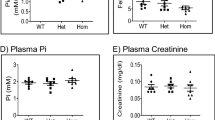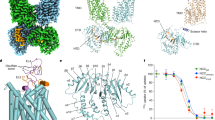Abstract
Mutations in the Na–K–2CI cotransporter (NKCC2), a mediator of renal salt reabsorption, cause Barrier's syndrome, featuring salt wasting, hypokalaemic alkalosis, hypercalciuria and low blood pressure. NKCC2 mutations can be excluded in some Bartter's kindreds, prompting examination of regulators of cotransporter activity. One regulator is believed to be ROMK, an ATP–sensitive K+ channel that ‘recycles’ reabsorbed K+ back to the tubule lumen. Examination of the ROMK gene reveals mutations that co–segregate with the disease and disrupt ROMK function in four Bartter's kindreds. Our findings establish the genetic heterogeneity of Bartter's syndrome, and demonstrate the physiologic role of ROMK in vivo.
This is a preview of subscription content, access via your institution
Access options
Subscribe to this journal
Receive 12 print issues and online access
$209.00 per year
only $17.42 per issue
Buy this article
- Purchase on Springer Link
- Instant access to full article PDF
Prices may be subject to local taxes which are calculated during checkout
Similar content being viewed by others
References
Lifton, R.P. Molecular genetics of human blood pressure variation. Science 272, 676–680, (1996).
Simon, D.B. et al. Gitelman's variant of Bartter's syndrome, inherited hypokalaemic alkalosis, is caused by mutations in the thiazide-sensitive Na-Cl cotransporter. Nature Genet. 12, 24–30 (1996).
Simon, D.B. et al. Bartter's syndrome, hypokalaemic alkalosis with hypercalciuria, is caused by mutations in the Na-K-2CI cotransporter NKCC2 . Nature Genet. 13, 183–188 (1996).
Wang, W., Sackin, H. & Giebisch, G. Renal potassium channels and their regulation. Annu. Rev. Physiol. 54, 81–96, (1992).
Giebisch, G. Renal potassium channels: an overview. Kidney Int. 48, 1004–1009 (1995).
Ho, K. et al. Cloning and expression of an inwardly rectifying ATP-regulated potassium channel. Nature 362, 32–38 (1993).
Yano, H. et al. Alternative Splicing of human inwardly rectifying K+ channel ROMK1 mRNA. Mol. Phamac. 45, 854–860 (1994).
Shuck, M.E. et al. cloning and characterization of multiple forms of the human kidney ROM-K potassium channel. J. Biol. Chem. 269, 24261–24270 (1994).
Lee, W.S. & Hebert, S.C. ROMK inwardly rectifying ATP-sensitive K+ cahnnel. I. Expression in rat distal nephron segments. Am. J. Physiol (Renal Fluid Electrol. Physiol.). 268, F1124–31 (1995).
Boim, M.A. et al. ROMK inwardly rectifying ATP-sensitive k+ channel. II. Cloning distribution of alternative forms. Am. J. Physiol (Renal Fluid Electrol. Physiol). 268, F1132–F1140 (1995).
Hebert, S.C., ATP-regulated, inwardly rectifying potassium channel from kidney (ROMK). Kidney Int 48, 1010–1016 (1995).
Lander, E.S. & Botstein, D. Homozygosity maping : away to map human recessive traits with the DNA of inbred children. Science 236, 1567–1570 (1987).
Orita, M. et al. Detection of polymorphisms of human DNA by gel electrophoresis as single-strand confromation polymorphisms. Proc. Natl. Acad. Sci. USA 86, 2766–2770. (1989).
Xu, Z.-C. et al. Phosphorylation of the ATP-sensitive, inwardly rectifying K+ channel, ROMK, by cyclic AMP-dependent protein kinase. J. Biol. Chem. 271, 9313–9319 (1996).
Bell, G., Karam, J. & Rutter, W. Polymorphic DNA region adjacent to the 5′ end of the human insulin gene. Proc. Natl. Acad Sci. USA 78, 5759–5763 (1981).
Lathrop, G.M. et al. Strategies for multilocus linkage in humans. Proc. Natl Acad. Sci. USA 81, 3443–3446 (1984).
Author information
Authors and Affiliations
Rights and permissions
About this article
Cite this article
Simon, D., Karet, F., Rodriguez-Soriano, J. et al. Genetic heterogeneity of Barter's syndrome revealed by mutations in the K+ channel, ROMK. Nat Genet 14, 152–156 (1996). https://doi.org/10.1038/ng1096-152
Received:
Accepted:
Issue Date:
DOI: https://doi.org/10.1038/ng1096-152
This article is cited by
-
A novel mutation of KCNJ1 identified in an affected child with nephrolithiasis
BMC Nephrology (2022)
-
The genetics of kidney stone disease and nephrocalcinosis
Nature Reviews Nephrology (2022)
-
Genetic diagnosis and treatment of hereditary renal tubular disease with hypokalemia and alkalosis
Journal of Nephrology (2022)
-
Pathophysiological aspects of the thick ascending limb and novel genetic defects: HELIX syndrome and transient antenatal Bartter syndrome
Pediatric Nephrology (2022)
-
Molecular mechanisms altering tubular calcium reabsorption
Pediatric Nephrology (2022)



